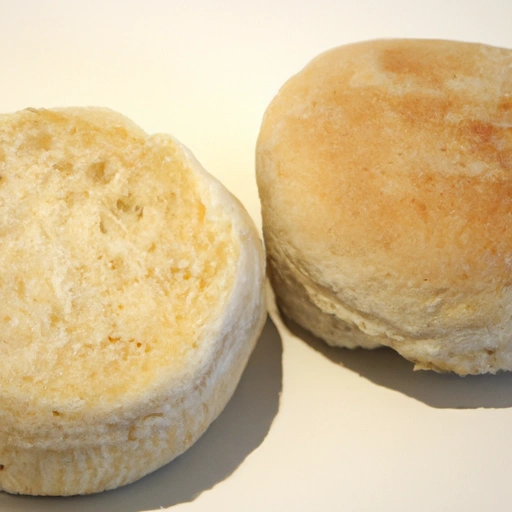English Muffin
Description

The English muffin is a small, round, and flat yeast-leavened bread which is commonly sliced horizontally, toasted, and buttered. It is often used as the bread in a variety of breakfast sandwiches and is a staple in both American and European diets. Unlike the sweeter, cupcake-like American muffin, the English muffin is more bread-like and has a distinctive airy texture due to the dough being cooked on a griddle rather than baked. This gives the English muffin its characteristic nooks and crannies, which are perfect for absorbing melted butter and other toppings.
Common uses
English muffins are most commonly used as a base for breakfast sandwiches and Eggs Benedict. They are also served as a toasted side with butter, jam, or honey. In some cases, they are used as a bread substitute for small, open-faced sandwiches or even mini pizzas.
Nutritional value
Calories
One medium-sized English muffin (approximately 57 grams) contains about 132 calories (552 kJ).
Protein
English muffins typically have about 5 grams of protein each.
Fat
They contain about 1 gram of fat, which is relatively low compared to other types of bread.
Carbohydrates
The carbohydrates content is usually around 25 grams per muffin.
Vitamins
English muffins often contain small amounts of B vitamins, especially niacin, riboflavin, and thiamine.
Minerals
They can also be a source of essential minerals such as calcium, iron, and potassium.
Health benefits
English muffins made with whole grains can be a good source of fiber which is beneficial for digestive health. The B vitamins present in English muffins are important for energy metabolism and maintaining a healthy nervous system.
Potential risks
For individuals with gluten sensitivity or celiac disease, regular English muffins, which are made with wheat, pose a risk due to their gluten content. Additionally, English muffins can contain added sugars and preservatives, which may not be suitable for all diets.
Common recipes
Popular recipes using English muffins include breakfast sandwiches with eggs, cheese, and bacon or sausage; Eggs Benedict with poached eggs, hollandaise sauce, and Canadian bacon; and mini muffin pizzas topped with tomato sauce, cheese, and various toppings.
Cooking methods
English muffins are typically split using a fork to preserve the texture and then toasted until golden brown. They can also be grilled, baked, or used fresh in various recipes.
Pairing with other ingredients
English muffins pair well with poached or fried eggs, smoked salmon, cream cheese, avocado, and a variety of sweet and savory spreads.
Summary
English muffins are a versatile food ingredient, known for their unique texture and ability to complement both sweet and savory dishes. They are an integral part of various traditional and contemporary recipes, beloved for their convenience and delicious taste. Whether used in classic breakfast dishes or as a creative component in appetizers and snacks, the English muffin is a culinary staple valued around the world.